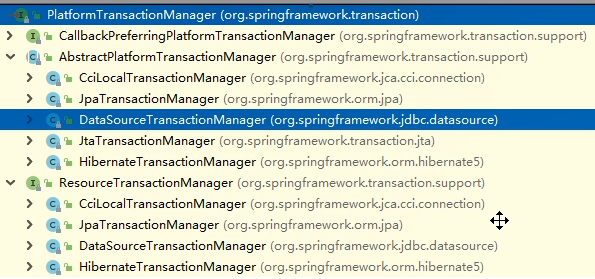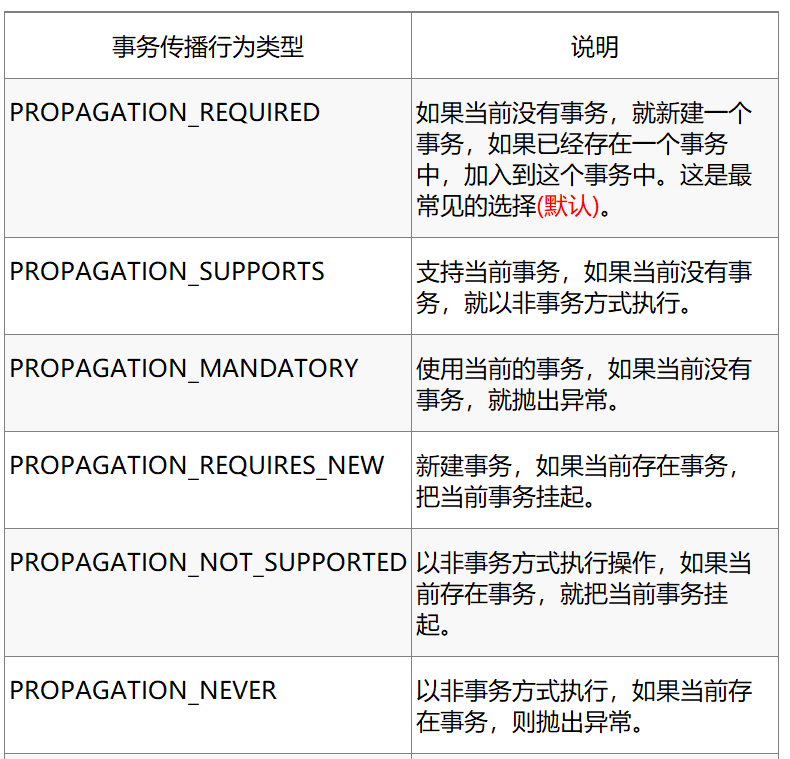18_Spring_事务管理注解方式
事务的管理应该放在我们的service层进行处理
spring中有两种事务的管理方式
1 编程式事务管理(了解)
2 声明式事务管理(掌握)
基于注解方式实现(掌握)
XML方式实现(了解)
Spring声明式事务的实现方式,底层就是AOP,AOP的底层就是动态代理
Spring事务管理相关的API
事务管理器接口: PlatformTransactionManager 针对不同的框架,提供了不同的实现类

注解方式实现事务控制
在applicationContext.xml配置事务相关的配置
在Service层中添加事务的注解
再次测试,就算是service方法运行出现异常,自动会回滚,如果没有,那么自动提交
@Transactional 注解的一些参数和参数的含义
@Transactional(propagation = Propagation.REQUIRED,isolation = Isolation.READ_UNCOMMITTED,readOnly = true,rollbackFor = ClassCastException.class,noRollbackFor = NullPointerException.class,timeout = 10)
propagation 事务的传播行为(面试)
多事务方法之间调用,事务是如何管理的


如果service层 add方法调用了 addDept和addEmp两个方法
PROPAGATION_REQUIRED
如果add方法有事务,那么addDept和addEmp就加入到add方法里的事务
如果add方法没有事务,那么就新建一个事务,将addDept和addEmp加入到这个新的事务中
PROPAGATION_REQUIRES_NEW
无论add是否有事务,都建立一个新的事务,所有的方法都加入到新的事务中,add原来的事务就不用了
isolation 事务的隔离级别
1) DEFAULT (默认)
这是一个PlatfromTransactionManager默认的隔离级别,使用数据库默认的事务隔离级别。另外四个与JDBC的隔离级别相对应。
MySQL默认REPEATABLE_READ
Oracle默认READ_COMMITTED
2) READ_UNCOMMITTED (读未提交)
这是事务最低的隔离级别,它允许另外一个事务可以看到这个事务未提交的数据。这种隔离级别会产生脏读,不可重复读和幻像读。
3) READ_COMMITTED (读已提交)
保证一个事务修改的数据提交后才能被另外一个事务读取,另外一个事务不能读取该事务未提交的数据。这种事务隔离级别可以避免脏读出现,但是可能会出现不可重复读和幻像读。
4) REPEATABLE_READ (可重复读)
这种事务隔离级别可以防止脏读、不可重复读,但是可能出现幻像读。它除了保证一个事务不能读取另一个事务未提交的数据外,还保证了不可重复读。
5) SERIALIZABLE(串行化)
这是花费最高代价但是最可靠的事务隔离级别,事务被处理为顺序执行。除了防止脏读、不可重复读外,还避免了幻像读。
timeout 超时时间
事务一定要在多长时间之内提交,如果不提交就会回滚
readOnly 只读事务
事务是否只能读取数据库的数据,如果为true,则不允许进行增删改
rollbackFor 指定发生回滚的异常
当方法发生哪些异常时才会回滚
noRollbackFor 指定不发生回滚的异常
当方法发生哪些异常时,不会回滚





【推荐】国内首个AI IDE,深度理解中文开发场景,立即下载体验Trae
【推荐】编程新体验,更懂你的AI,立即体验豆包MarsCode编程助手
【推荐】抖音旗下AI助手豆包,你的智能百科全书,全免费不限次数
【推荐】轻量又高性能的 SSH 工具 IShell:AI 加持,快人一步
· 全程不用写代码,我用AI程序员写了一个飞机大战
· MongoDB 8.0这个新功能碉堡了,比商业数据库还牛
· 记一次.NET内存居高不下排查解决与启示
· DeepSeek 开源周回顾「GitHub 热点速览」
· 白话解读 Dapr 1.15:你的「微服务管家」又秀新绝活了